How TPN is Used to Treat Nutritional Deficiencies in Intensive Care Units

The Vital Role of Parenteral Nutrition in ICU Patients
Total Parenteral Nutrition (TPN) plays a crucial role in the management of critically ill patients within ICU settings, especially when traditional enteral feeding methods are contraindicated or insufficient. Understanding how TPN is used, its indications, formulation, administration, benefits, and risks is essential for optimizing patient outcomes in these high-stakes environments.
Understanding Total Parenteral Nutrition (TPN) in Critical Care
What is Total Parenteral Nutrition (TPN) and how is it used to treat nutritional deficiencies?
Total Parenteral Nutrition (TPN) is a specialized method of feeding that involves delivering all necessary nutrients directly into a patient's bloodstream through an intravenous line. This approach is used when the gastrointestinal (GI) tract cannot be used to absorb nutrients effectively. Patients who require TPN often have conditions such as severe intestinal failure, extensive bowel surgery, or disorders like radiation enteritis.
The primary goal of TPN is to prevent or correct malnutrition, dehydration, and electrolyte imbalances. It supplies a carefully balanced mixture of macronutrients—including carbohydrates (dextrose), lipids (fat emulsions), and amino acids (proteins)—as well as essential micronutrients like vitamins and minerals. These nutrients are tailored to meet individual patient needs based on their metabolism, disease state, and nutritional status.
Route of administration
TPN is administered intravenously, typically through a central line such as a tunneled catheter or PICC line, which allows for the delivery of a hyperosmolar nutrient solution. In some cases, peripheral lines may be used for short-term support, but these are limited by osmolality constraints.
Components of TPN
The composition of TPN includes:
- Lipid emulsions for fat calories and essential fatty acids
- Dextrose as the carbohydrate source
- Amino acids for protein needs
- Vitamins and trace elements to support metabolic processes
- Electrolytes and minerals to maintain fluid and electrolyte balance
Monitoring and adjusting these components regularly are vital to optimizing therapy and minimizing complications such as hyperglycemia, electrolyte imbalance, or fatty liver.
Purpose in ICU
In critical care settings, TPN plays a vital role, especially when patients are unable to receive enteral nutrition due to gastric motility issues, bowel obstructions, or ongoing surgeries. It is also crucial in neonatal intensive care units and for patients with severe trauma, burns, or malignancies.
While enteral nutrition is preferred because of its physiological benefits and lower cost, TPN remains an essential alternative in situations where gut feeding is contraindicated or ineffective. It requires careful management, including regular assessment of body weight, blood tests, and clinical signs to ensure safety and efficacy.
Indications for TPN in Critically Ill Patients
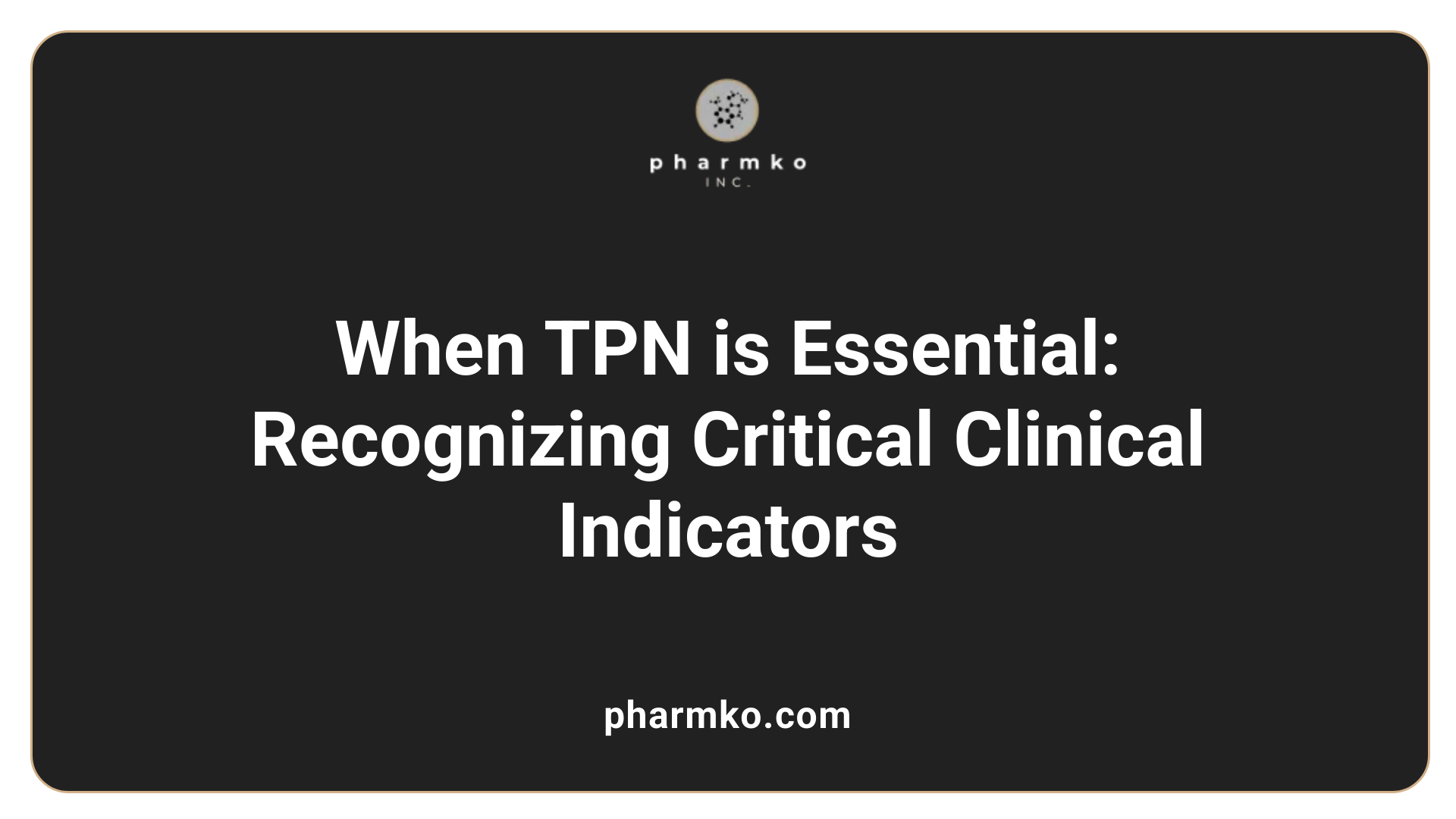
In which clinical situations is TPN indicated in critically ill patients?
TPN, or total parenteral nutrition, becomes crucial in certain clinical scenarios where traditional enteral feeding cannot meet the nutritional needs of patients. It is primarily used when the gastrointestinal (G.I.) tract is non-functional or inaccessible.
Critical conditions such as massive small-bowel resection, radiation enteritis, severe diarrhea, or bowel obstructions often prevent the effective use of enteral routes. In these cases, TPN provides essential nutrients directly into the bloodstream, bypassing the G.I. tract.
Patients with severe trauma, burns, postoperative infections, or malabsorption syndromes also frequently rely on TPN. It is particularly important in cases of gastrointestinal failure, where the gut cannot digest or absorb nutrients properly.
In neonates and pediatric patients with malnutrition or those who have gastrointestinal anomalies, TPN supports growth and recovery.
In recent times, TPN has played an important role in managing patients with COVID-19 who experience prolonged ICU stays, ensuring adequate nutrition during critical phases of illness.
Deciding when to initiate TPN involves careful assessment of each patient's nutritional status, G.I. function, and potential risks like infections or metabolic complications.
Summary Table:
| Clinical Scenario | TPN Indication | Explanation |
|---|---|---|
| Severe bowel dysfunction or resection | Yes | Gut cannot absorb nutrients effectively |
| Critical illness with contraindicated enteral feeding | Yes | Enteral routes are unsafe or impossible |
| Malabsorption syndromes | Yes | Nutrients are not properly absorbed |
| Gastrointestinal obstruction or ileus | Yes | Gut rest needed; TPN bypasses G.I. issues |
| Neonatal and pediatric nutritional support | Yes | Especially when G.I. development or function is compromised |
| Prolonged ICU stay with nutritional deficits | Yes | When oral/enteral feeding is not sufficient |
Monitoring and individualized planning are essential to ensure safe and effective use of TPN in these situations, helping improve clinical outcomes and patient recovery.
Methods and Procedures of TPN Administration in ICU
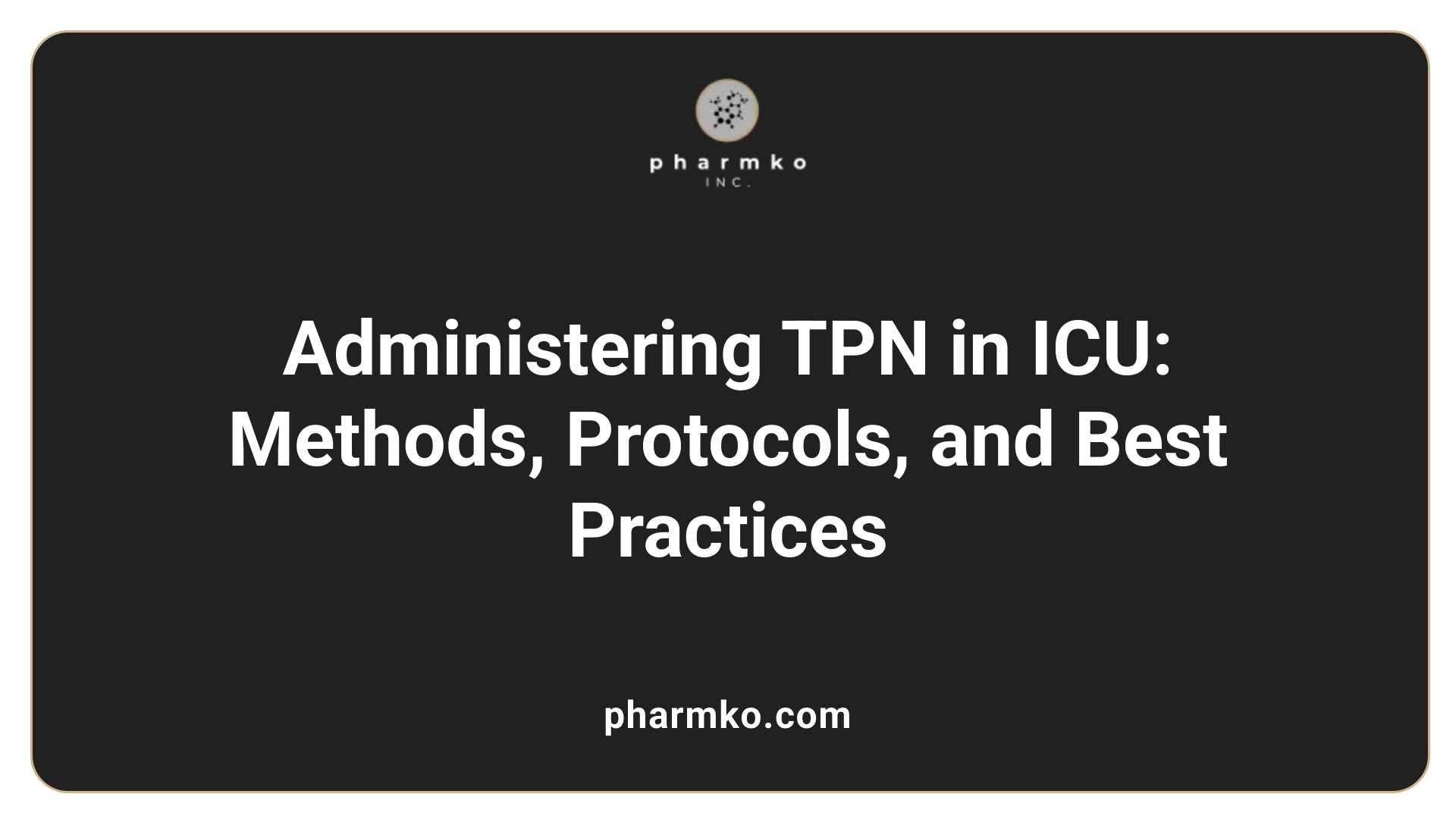
How is TPN administered in the ICU, and what are the clinical guidelines for its use?
Total Parenteral Nutrition (TPN) is usually administered through a central venous catheter in ICU patients. This allows the infusion of hyperosmolar solutions necessary to meet high caloric and protein needs efficiently.
The selection of catheter type—such as tunneled catheters, non-tunnelled catheters, or peripherally inserted central catheters (PICC lines)—depends on the expected duration of therapy and patient condition.
Clinical guidelines stress the importance of sterile technique during insertion and handling of the catheter to minimize infection risks. Regular monitoring involves assessing blood glucose, electrolytes, liver function, and triglyceride levels to detect and address potential complications early.
Formulation adjustments are made based on ongoing evaluations of nutritional needs, metabolic responses, and laboratory results. This often includes customizing the macro- and micronutrient composition, aiming to prevent overfeeding and ensure compatibility with the patient’s clinical state.
Monitoring is critical during TPN therapy, involving frequent assessments of body weight, signs of infection, and lab tests, to ensure safe and effective nutritional support. TPN initiation and titration follow strict protocols to match patient-specific energy and nutrient requirements, often guided by objective measures like indirect calorimetry.
Overall, the administration of TPN in ICU settings requires diligent planning, continuous monitoring, and adjustments tailored to the individual patient’s evolving condition, with safety and efficacy being the primary focus.
Clinical Guidelines for TPN Use in ICU
What are the clinical guidelines for TPN use in ICU?
The guidelines recommend that TPN should be used when enteral nutrition is insufficient or contraindicated, typically after the third to seventh day of ICU admission. They emphasize the importance of individualized nutrition plans based on precise assessment of caloric needs, often measured through indirect calorimetry.
Timing of initiation is critical. Enteral nutrition is preferred within the first 48 hours when possible, with TPN reserved for cases where enteral feeding cannot meet at least 50% of caloric requirements after a few days. Early use of TPN within 24 hours may benefit some malnourished patients but should be approached cautiously.
Assessment of nutritional requirements involves evaluating energy expenditure and nutritional status, frequently through measurements like indirect calorimetry and nitrogen balance studies. Precise dosing of macronutrients ensures optimal outcomes and minimizes risks.
Monitoring during TPN therapy includes frequent checks of blood glucose, electrolytes, triglycerides, and organ functions. Tight glucose control, maintaining blood glucose levels between 6 and 8 mmol/l, is crucial to avoid hyperglycemia-related complications.
Avoiding overfeeding is essential, especially of carbohydrates, to prevent fatty liver and metabolic disturbances. Careful calculation of calorie and micro-nutrient content, along with gradual advancement of nutrition formulas, helps reduce these risks.
In summary, clinical practice advocates for cautious, personalized TPN support in critically ill patients, with regular monitoring to optimize patient outcomes and minimize complications.
Potential Benefits of TPN in Critical Care
What are the potential benefits of TPN in critically ill patients?
Total parenteral nutrition (TPN) plays a crucial role in managing patients who are unable to receive adequate nutrition via the gastrointestinal (GI) tract. One of its main advantages is its ability to prevent malnutrition in critically ill patients, which, if left unaddressed, can worsen illness outcomes.
In addition to nutritional support, TPN can bolster immune function. Specialized formulas enriched with nutrients such as arginine, glutamine, nucleotides, and omega-3 fatty acids have been shown to reduce infection rates, wound complications, and shorten hospital stays.
Tailored nutrient delivery is another key benefit of TPN. It allows healthcare providers to customize the composition based on individual patient needs, including precise calorie, protein, vitamin, and mineral amounts. This personalized approach helps avoid complications related to overfeeding or underfeeding.
When managed correctly, TPN has been linked with improved clinical outcomes. It can support recovery in conditions where enteral feeding is contraindicated or insufficient, ultimately contributing to better patient recovery, reduced morbidity, and shorter ICU stays.
While it has its risks, with proper monitoring and formulation, TPN remains an essential alternative in the critical care setting, especially when the GI tract is compromised or nonfunctional.
Risks and Complications Linked to TPN
What are the common risks and complications associated with TPN?
Total Parenteral Nutrition (TPN) is vital for patients who cannot absorb nutrients through their gastrointestinal tract. However, it comes with various possible risks that require careful management.
One of the primary concerns is the risk of infections. Because TPN involves inserting a central or peripheral line for intravenous delivery, these lines can be entry points for bacteria, leading to bloodstream infections. Strict aseptic techniques and vigilant line care are essential to reduce this danger.
Metabolic disturbances are another major issue. Overfeeding, especially with excessive carbohydrates, can result in fatty liver, hyperglycemia, and burnout of organs such as the liver and pancreas. Proper dosing, regular monitoring of blood glucose levels, and gradual adjustments are crucial.
Liver dysfunction or cholestasis can develop with long-term TPN use, manifesting as elevated liver enzymes and impaired liver function. Regular liver function tests are necessary to identify and address early signs of hepatic complications.
Electrolyte imbalances are also common, including abnormalities in sodium, potassium, calcium, and magnesium levels. These imbalances can lead to serious complications like cardiac arrhythmias or neuromuscular issues. Frequent blood tests and individualized electrolyte management help maintain balance.
Careful patient monitoring, routine laboratory testing, and adherence to guidelines are fundamental to minimizing these risks and ensuring safe TPN therapy.
Formulation and Customization of TPN for ICU Patients
How is TPN formulated and tailored to individual ICU patient needs?
Total parenteral nutrition (TPN) is a specialized therapy designed to meet the unique nutritional requirements of critically ill patients when enteral feeding is not feasible. Its formulation involves a careful combination of macronutrients—dextrose (carbohydrates), amino acids (protein), and lipid emulsions—alongside a spectrum of micronutrients including vitamins, minerals, electrolytes, and trace elements.
The process begins with a comprehensive assessment of the patient's nutritional status, considering factors such as age, weight, metabolic demands, and specific clinical conditions like renal or liver impairment. Based on this, healthcare providers determine the initial composition, setting target caloric intake and protein levels. For many ICU patients, higher protein doses—around 1.3 g/kg/day—are often required to support tissue repair and immune function.
Laboratory tests are integral to ongoing adjustments. Regular monitoring of blood glucose, serum electrolytes, liver and kidney function, and triglyceride levels guides clinicians in modifying the TPN formulation. For instance, if blood glucose is elevated, carbohydrate delivery may be reduced, and insulin may be incorporated to maintain tight glycaemic control.
Lipid emulsions are tailored to modulate inflammatory responses; types rich in omega-3 fatty acids can be used to potentially improve outcomes in some settings. Fluid volume is also adjusted to prevent overload or dehydration.
This personalized approach often involves a multidisciplinary team including physicians, dietitians, and pharmacists, who utilize protocols and continuous monitoring to optimize nutritional adequacy while minimizing risks. Adjustments are made over time based on patient progress, laboratory results, and changes in clinical status.
In summary, TPN formulation is a dynamic, patient-specific process that aims to restore nutritional balance, support recovery, and prevent complications such as refeeding syndrome, fatty liver, or electrolyte imbalances.
Role of TPN When Enteral Nutrition Is Not Feasible
What is the role of TPN when enteral nutrition is not feasible or contraindicated?
Total Parenteral Nutrition (TPN) is essential for patients who cannot receive adequate nutrition through their gastrointestinal (GI) tract. When enteral feeding is not possible—due to conditions like bowel obstruction, severe diarrhea, or bowel paralysis—TPN provides necessary nutrients directly into the bloodstream via intravenous access. This bypasses the GI system entirely and helps maintain the patient’s nutritional status.
TPN is particularly important in critical conditions such as massive small-bowel resection, high-output fistulas, and severe intestinal failure. It supplies a balanced mixture of nutrients, including amino acids, glucose, lipids, vitamins, and minerals, supporting organ function and preventing malnutrition.
While lifesaving, TPN requires careful management. Risks include infections, metabolic imbalances, and liver issues, thus necessitating vigilant monitoring. Overall, TPN serves as a vital bridge to recovery when the GI tract cannot be used for feeding, ensuring patient stability and nutritional adequacy during critical periods.
Utilization of TPN in Specific Patient Populations Including COVID-19
In which patient populations, such as COVID-19 patients, is TPN used in intensive care?
Total parenteral nutrition (TPN) plays a crucial role in supporting critically ill patients who cannot receive adequate nutrition through enteral routes. In COVID-19 patients, TPN is frequently used when gastrointestinal involvement prevents safe or effective oral or enteral feeding. Severe COVID-19 infections often require prolonged mechanical ventilation and sedation, which can compromise gastric motility and increase the risk of aspiration. Additionally, gastrointestinal symptoms such as diarrhea, ileus, or bowel ischemia can make enteral nutrition unsafe or impossible.
Patients with bowel obstructions, fistulas, or after extensive abdominal surgeries are other groups where TPN becomes necessary. It is especially important if enteral feeding does not meet at least 50% of their caloric needs after 3 to 7 days in ICU.
The timing for initiating TPN typically falls between the third and seventh day of ICU admission if oral or enteral routes are contraindicated or insufficient. This approach aims to prevent muscle wasting, immune dysfunction, and malnutrition. TPN formulations for these populations are tailored to meet high energy and protein demands, with careful monitoring to avoid complications such as infections and metabolic disturbances.
Overall, TPN ensures nutritional support for various critical illness populations, including COVID-19 patients, when traditional feeding methods are not feasible or effective, which is vital for improving clinical outcomes.
Principles Underlying TPN Formulation and Nutrition Planning in ICU
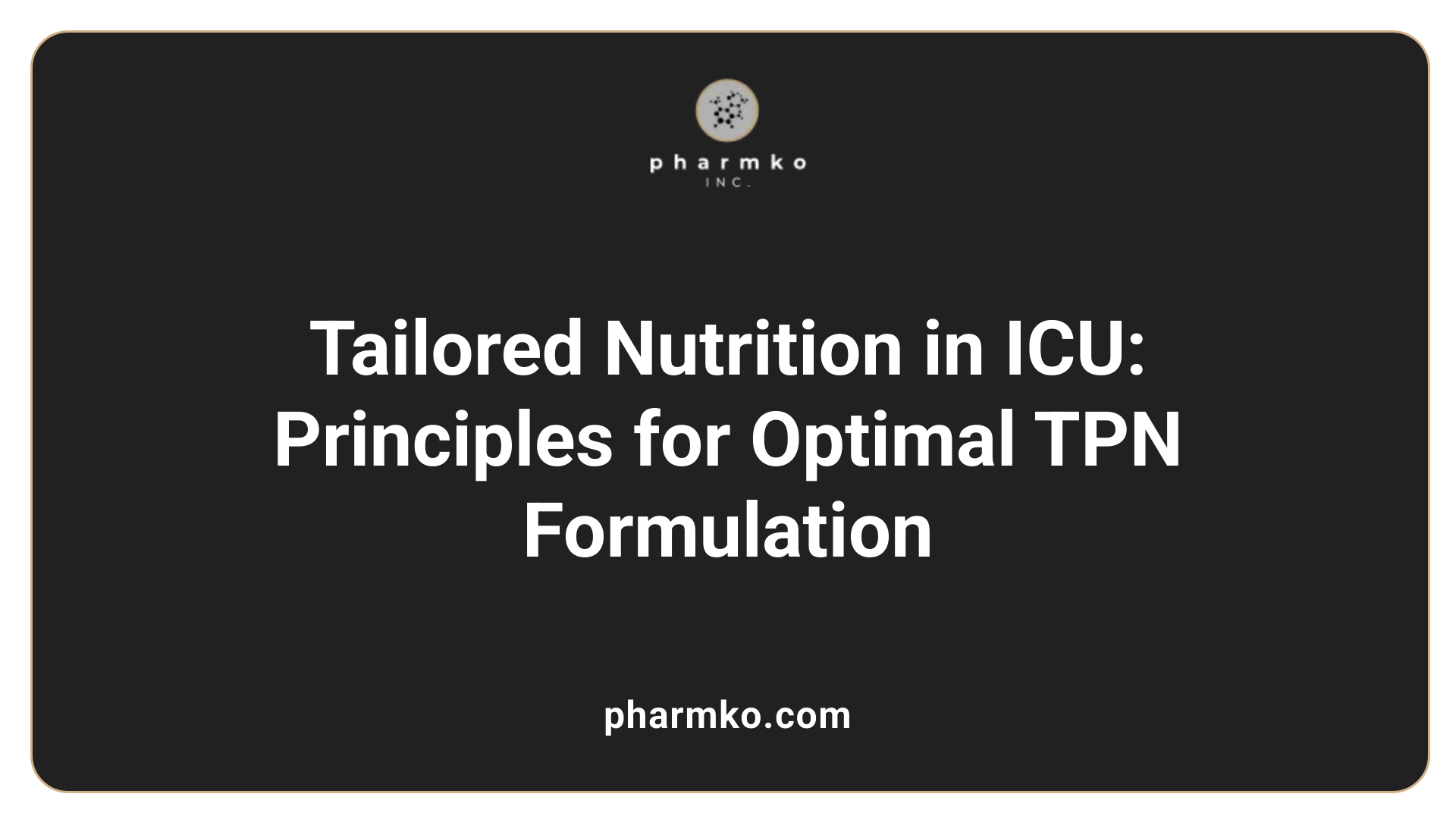
What principles underpin TPN formulation and individualized nutrition plans in critical care?
In the intensive care setting, Total Parenteral Nutrition (TPN) must be carefully tailored to meet each patient's unique needs. The primary principles involve accurate assessment and balancing of macro and micronutrients to ensure optimal recovery while minimizing complications.
A crucial step in TPN formulation is determining the patient's energy requirements. This is often achieved through indirect calorimetry, which provides a precise measurement of resting energy expenditure. This helps avoid overfeeding, which can cause issues like fatty liver or hyperglycemia, and underfeeding, which may impair healing and immune function.
Protein provision is also customized. Typical recommendations range around 1.3 g/kg/day, but adjustments depend on factors such as muscle mass, metabolic state, and specific clinical conditions. Adequate protein intake supports tissue repair, immune response, and maintains lean body mass.
The carbohydrate and fat components are balanced to meet the energy needs without causing metabolic disturbances. Carbohydrates must be carefully administered to prevent hyperglycemia, especially during stress or critical illness, while fats provide essential fatty acids, including omega-3 and omega-9, necessary for cell function.
Supplementing micronutrients—vitamins, minerals, and trace elements—is individualized as well, based on laboratory assessments and ongoing clinical evaluation. This holistic approach helps correct deficiencies and supports overall health.
Throughout the nutritional support process, regular monitoring of blood glucose, electrolytes, liver function, and other labs guides necessary adjustments. The goal is to deliver a safe, effective, and personalized nutritional regimen that supports patient recovery, maintains immune function, and reduces the risk of complications such as refeeding syndrome or electrolyte imbalances.
By adhering to these principles, ICU teams can optimize nutrition therapy, enhancing healing and improving outcomes in critically ill patients.
Monitoring and Managing TPN-Related Complications
How is TPN monitored and how are complications managed?
Effective supervision of total parenteral nutrition (TPN) involves comprehensive monitoring to ensure patient safety and optimize outcomes. Regular blood tests are essential for detecting metabolic disturbances, infections, and nutrient deficiencies. These tests typically include serum electrolytes, blood glucose, triglycerides, liver function panels, and nitrogen balance assessments.
In addition to lab work, clinicians perform periodic clinical evaluations, observing for signs of complications such as catheter-related infections, electrolyte imbalances, or liver issues. Strict aseptic techniques and meticulous catheter care are crucial in preventing infections, which remain one of the most common TPN complications.
Adjustment of TPN therapy is a key part of management. Based on lab results, clinicians may modify the nutritional formula, decreasing glucose or lipid content to prevent hyperglycemia or hepatic complications. Micronutrient and electrolyte levels are closely monitored to prevent deficiencies or toxicities. In cases of hyperglycemia, insulin therapy may be initiated, whereas hypoglycemia requires prompt carbohydrate administration.
Managing electrolyte disturbances involves balancing sodium, potassium, magnesium, and calcium levels, which requires frequent blood checks. For patients developing signs of cholestasis or liver dysfunction, TPN formulas can be adjusted to include alternative lipid sources or reduced fat content.
Early detection of adverse effects—such as hyperglycemia, hypoglycemia, electrolyte imbalances, or infections—is vital for timely intervention. This often involves a multidisciplinary approach, including physicians, nurses, dietitians, and pharmacists, to tailor therapy and minimize risks.
Ultimately, careful, consistent monitoring paired with prompt adjustments helps prevent serious complications, ensuring TPN remains a safe, supportive therapy for patients unable to meet their nutritional needs through enteral routes.
Guidelines for Initiating and Discontinuing TPN in ICU
When should TPN be initiated and how should it be discontinued?
Total Parenteral Nutrition (TPN) is an essential intervention when critically ill patients cannot meet their nutritional needs through enteral routes. The timing of TPN initiation typically falls between the 3rd and 7th day after ICU admission, especially when enteral feeding is inadequate or contraindicated.
Before starting TPN, healthcare providers should assess the patient’s nutritional status, risks, and specific clinical condition. Indications such as severe malnutrition, gastrointestinal failure, or conditions like bowel obstruction warrant early consideration of parenteral nutrition.
The initiation process involves calculating individualized caloric and nutrient goals, often guided by indirect calorimetry, to avoid overfeeding and associated complications. Catheter placement requires sterile technique to minimize infection risks, with central lines preferred for hypertonic solutions.
Discontinuation of TPN should occur once enteral or oral nutrition can adequately meet the patient’s energy and nutrient requirements. This transition must be carefully managed through gradual weaning to avoid metabolic disturbances such as hypoglycemia, electrolyte imbalances, or refeeding syndrome.
Ongoing monitoring is critical during both TPN administration and weaning. Evaluations include regular assessment of blood glucose, electrolytes, liver function, and clinical status. Planning the transition to enteral or oral feeding should be part of daily ICU management, ensuring a smooth switch to less invasive nutrition methods.
Using a patient-centered approach, clinicians should tailor TPN duration and weaning strategies based on individual recovery trajectories, nutritional needs, and tolerance levels.
Special Considerations for TPN in Neonates and Pediatric ICU Patients
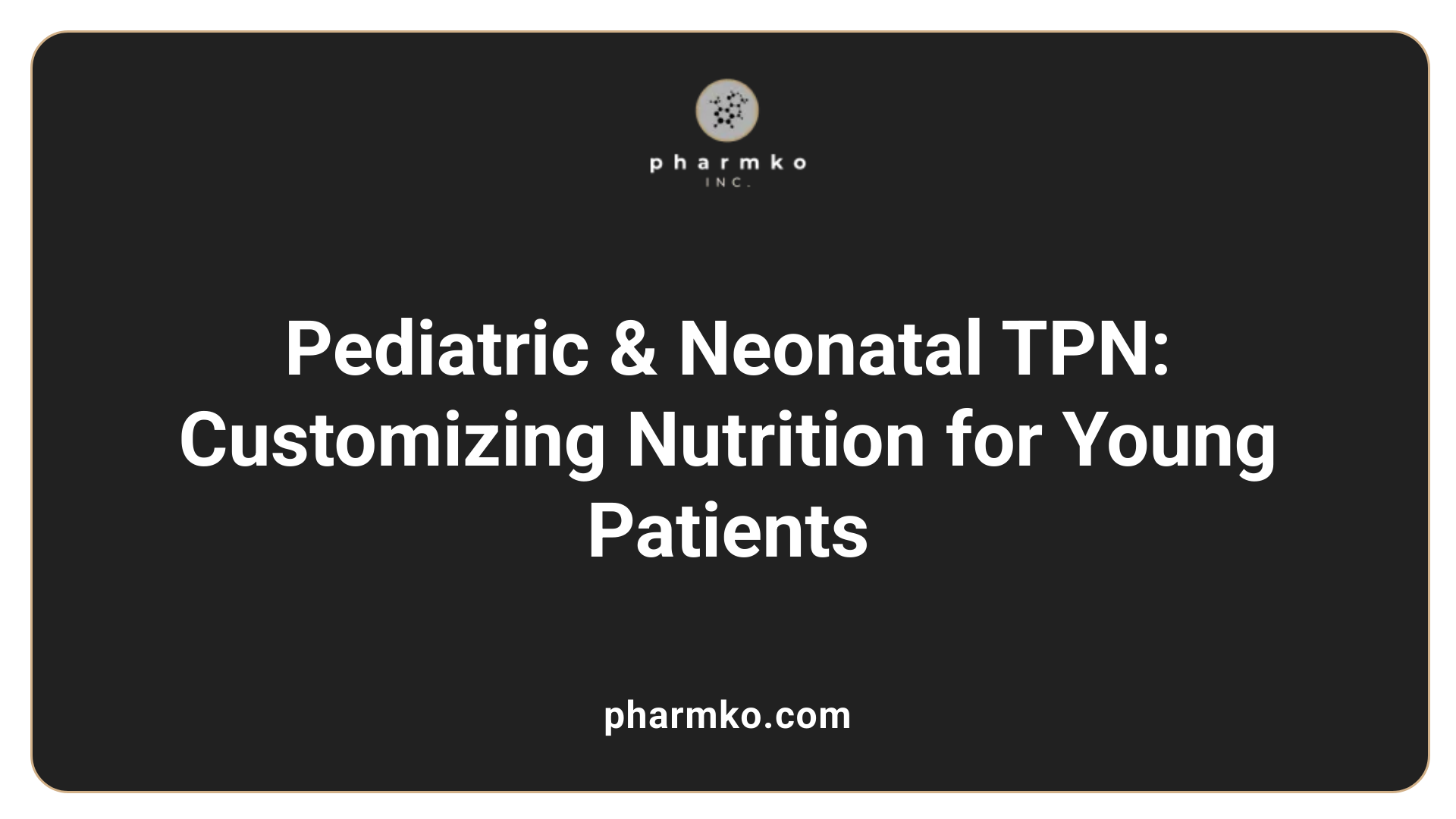 In neonatal and pediatric ICU populations, TPN requires specially formulated nutrients that account for age-specific needs, growth, and developmental stage. These customized formulations include appropriate levels of amino acids, lipids, vitamins, and minerals tailored to young patients.
In neonatal and pediatric ICU populations, TPN requires specially formulated nutrients that account for age-specific needs, growth, and developmental stage. These customized formulations include appropriate levels of amino acids, lipids, vitamins, and minerals tailored to young patients.
Monitoring is crucial for these populations and involves regular assessment of body weight, blood chemistries (such as electrolytes, blood glucose, and liver function tests), and organ health. This vigilance helps detect and manage potential complications like hypoglycemia, electrolyte disturbances, or liver dysfunction early.
The nutritional support aims to promote healthy growth, support recovery from critical conditions, and prevent deficiencies that might impair development. Careful adjustment of the TPN mixture ensures that the nutritional needs for growth are met without overfeeding, which can cause issues such as fatty liver or metabolic imbalances.
Overall, multidisciplinary teams—including neonatologists, pediatric intensivists, and dietitians—play a vital role in administering and adjusting TPN to optimize outcomes and ensure safe, effective nutrition therapy for young patients.
Future Strategies and Innovations in ICU Nutritional Support
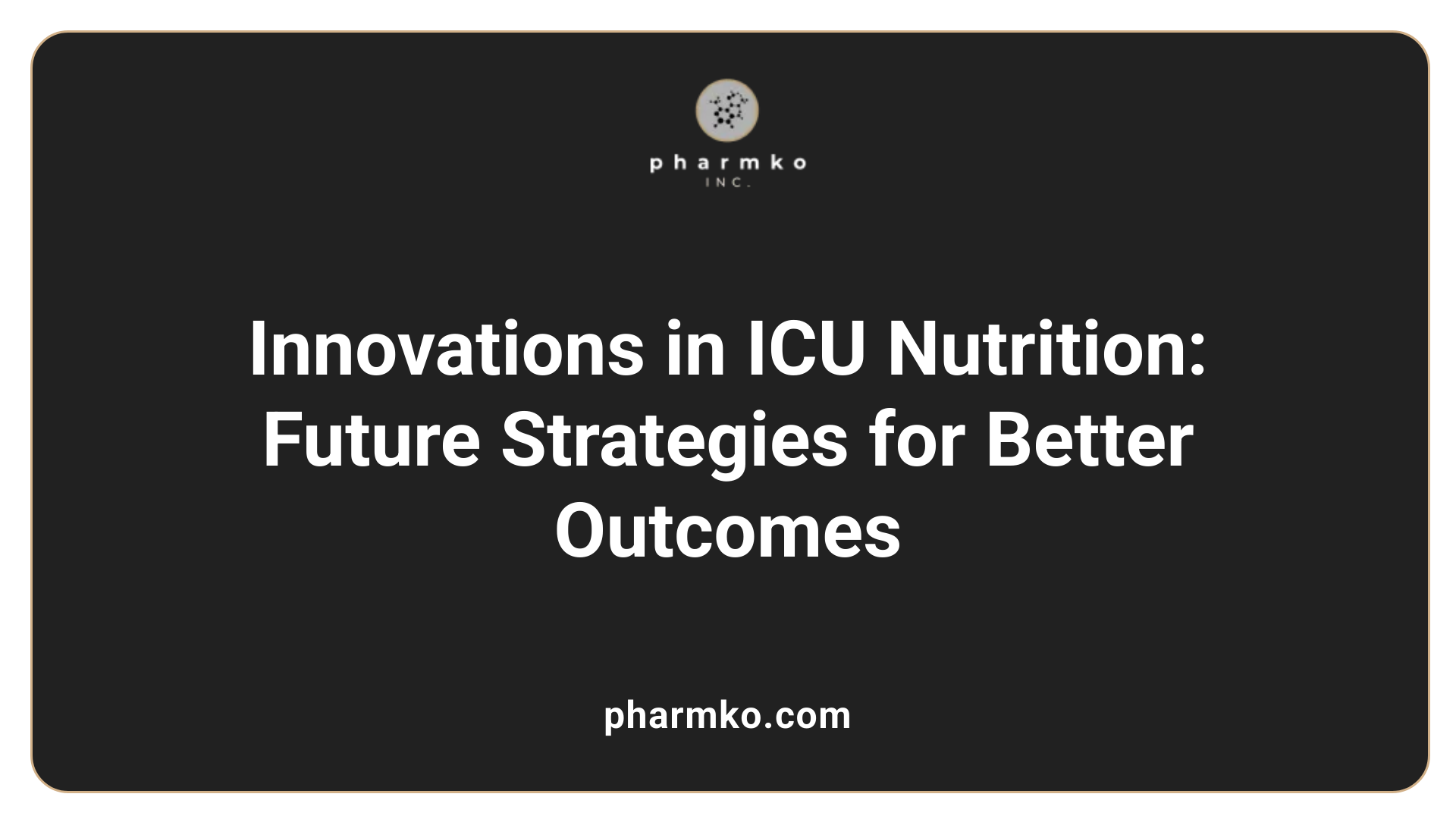
What future strategies are anticipated for managing hyperglycemia and nutrition support in ICU?
Looking ahead, the management of nutrition support and hyperglycemia in ICU patients is poised for significant advancements. One promising approach involves integrating computer-based algorithms to tailor nutrition plans for each patient, ensuring precise calorie and nutrient delivery while minimizing risks of overfeeding or deficiencies.
Furthermore, the development of physician-led teams dedicated to nutritional therapy will enhance coordination and expertise, leading to more effective patient care. These teams can swiftly adapt nutritional strategies based on real-time monitoring and evolving patient conditions.
Innovations in micro-nutrient formulations are also on the horizon. Updated supplements containing specific nutrients like arginine, glutamine, nucleotides, and omega-3 fatty acids are being refined to boost immune function, reduce infection rates, and promote faster recovery.
Controlling blood glucose levels remains a critical focus. Future therapies aim to improve glucose regulation, reducing hyperglycemia-related complications. This might involve novel insulin delivery methods, smarter glucose sensors, and targeted therapies tailored to critically ill patients.
Overall, these strategies aim to optimize nutritional support, improve patient outcomes, and reduce ICU stays, aligning with ongoing research and technological progress in critical care medicine.
Summary and Key Takeaways on TPN in ICU Settings
What are the key points to remember about TPN use in ICU?
In summary, Total Parenteral Nutrition (TPN) serves as a critical nutritional support method for ICU patients when enteral feeding isn’t feasible due to gastrointestinal issues or contraindications. Its primary role is to prevent or treat malnutrition, which is common among critically ill patients, especially those with severe trauma, malabsorption, or bowel obstructions.
The formulation of TPN must be individualized, considering calorie, protein, electrolyte, and micronutrient requirements. It often includes lipids, dextrose, amino acids, vitamins, and minerals, delivered via central or peripheral lines. Monitoring is essential; regular assessments of blood glucose, electrolytes, liver function, and signs of infection are vital to detect and manage potential complications.
While TPN provides essential nutrients, it carries risks such as infections related to catheter use, hyperglycemia, electrolyte imbalances, and liver dysfunction. Overfeeding, especially with carbohydrates, should be avoided to prevent fatty liver and other metabolic issues.
Guidelines recommend initiating enteral nutrition within 48 hours of ICU admission whenever possible, reserving TPN for cases where enteral feeding is contraindicated or insufficient after several days. A multidisciplinary team approach—including physicians, dietitians, and nurses—is crucial for safe TPN management.
In addition, the use of immune-enhancing formulas containing arginine, glutamine, nucleotides, and omega-3 fatty acids has shown promise in reducing infections and hospital stay durations, although higher costs and the need for further research remain considerations.
Overall, careful planning, timely initiation, continuous monitoring, and adherence to established protocols are necessary to maximize TPN benefits and minimize risks, ultimately improving patient outcomes in intensive care settings.
The Importance of Personalized Nutrition in Critical Care
Optimizing nutritional support through carefully managed TPN improves clinical outcomes in ICU patients. Tailored formulations, vigilant monitoring, and adherence to guidelines are vital for minimizing risks and supporting recovery. As research advances, strategies such as innovative micro-nutrient supplementation and sophisticated monitoring will further refine the role of TPN in critical care, ultimately enhancing patient survival and well-being.
References
- Nutrition Management in the ICU
- Nutrition Support in the Intensive Care Unit
- Nutritional support for critically ill patients in the intensive ...
- Total parenteral nutrition: A boon to non-functional ...
- Parenteral nutrition in the intensive care unit: cautious use ...
- Nutritional Intervention in Critical Care | Respiratory Therapy
- Role Of Total Parenteral Nutrition (TPN) In Critically Ill ICU ...








































































































